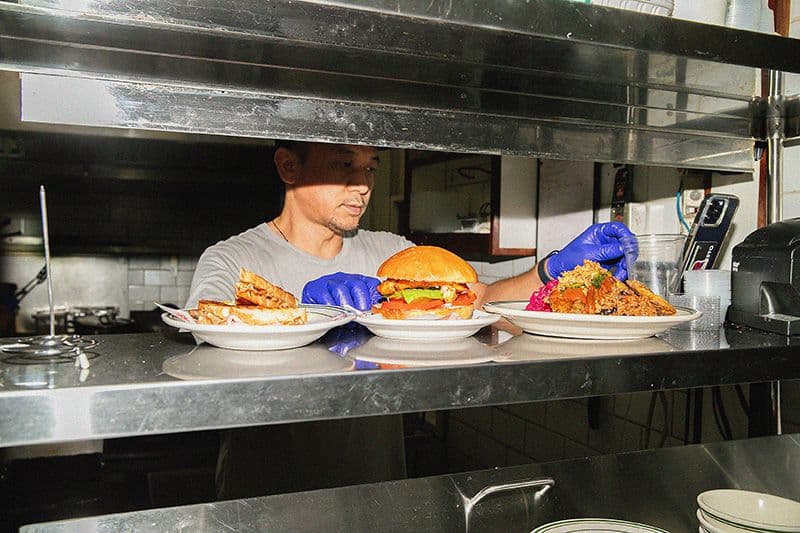The holidays are on their way and the hectic season pushes many people to eat out rather than cook. Doordash reported that Christmas and New Year’s are the busiest holidays for food delivery.
Many restaurants are still working around hiring and staff retention struggles, meaning they may be unable to fully capitalize on the demand of the holidays. That’s where proper holiday work scheduling comes into play — and with the right combination of tools, organization, and communication, restaurants and their teams will soar through the holiday season with more ease than Santa on his sleigh.
Does Your Restaurant Need a Holiday Work Schedule?
While every restaurant should properly plan out its work schedule during the holidays (and year-round, for that matter), not every restaurant needs to drastically overhaul its schedule when December rolls around.
Before making major changes to your employees’ work schedules, here are a few questions to ask.
1. How do sales change during the holidays?
For restaurants that have years of sales data, the first place to look is metrics from prior holiday seasons. You can reference average party size, takeout vs. on-premise orders, the popular menu items, and other key metrics to forecast restaurant sales.
If sales don’t differ too much from the rest of the year, your restaurant might not need much extra consideration for staffing outside special events.
For newer restaurants without historical data, reference metrics for other major holidays like Mother’s Day, graduation season, or Valentine’s Day to paint a picture of how the restaurant’s demand might shift during the end of the year.

2. How staffed up is the restaurant?
Building a holiday work schedule is only effective if employees are available to work assigned shifts. As such, your restaurant should analyze its current staffing situation so that any adjustments that are made for the holidays are feasible.
For example, you might only have four bartenders on staff, but with private parties and holidays like New Year’s Eve and Thanksgiving Eve on the horizon, your restaurant may need more than that.
It’s important to head into the holidays with a clear understanding of where you may need to staff up versus what areas of the restaurant have ample employees. We’ll touch on a few ways to bring on more workers in time for the holidays later on in this post.
3. Are there any events that have special staffing needs?
Finally, before building a holiday schedule, your restaurant needs a plan for its restaurant events program. If your restaurant doesn’t have events, skip to the next step.
However, if your restaurant is a desired venue for holiday events, your staffing may need to be adjusted depending on their size, nature, and frequency. For example, extra help might be needed to prepare, deliver, and serve catering.
Gathering Employee Availability & Feedback
Once you’ve determined the need to adjust your schedule for the holidays, the next step is to work with employees on their availability to build schedules that work for them and your customers.
Naturally, the holidays are among the most common reasons for employees to request time off. If demand is indeed higher in your restaurant during the holidays, you may be faced with the tough decision of granting some time-off requests and rejecting others. That’s why you should encourage employees to submit these requests as soon as possible so that schedules don’t need to be constantly revised.
Employees can also submit any extra availability during the holidays using restaurant scheduling tools to give you a bigger pool of available workers for each shift. Keep in mind, however, that overtime pay could be necessary in these circumstances.
In a pinch, you can also rely on a team communication tool to allow employees to trade or offer up their shifts to a coworker to avoid an understaffed holiday event.

Hire Additional Staff in Time
For restaurants that are understaffed heading into the holidays, it’s not too late to staff up for the busy season. In fact, the sooner you begin the search for new candidates, the more likely you’ll find and hire qualified workers — and the more time you’ll have to train them, so they’re fully ramped come December.
The bad news for restaurants is that food service businesses are facing ongoing difficulty hiring. 65% of restaurant operators say the labor market is tight, according to our Restaurant Workforce Report. Restaurants have to be more proactive than ever before when staffing up for the holidays. The good news is that with the holidays comes an influx of individuals looking for temporary work — with many seasonal workers seeking short-term employment in restaurants.
Regardless of if these new hires are temporary or permanent,part-time or full-time, or BOH or FOH, they should be hired promptly and confidently.
Here are a few tips for sourcing, hiring, and training enough employees to get you through the holidays — and then some.
Holiday Referral Sprints
Your employees love working at your restaurant – so why not recruit them to get more help finding new employees?
This is where an employee referral program for the holidays comes into play. This program incentivizes employees to tap into their networks and refer people to work in your restaurant in exchange for a reward, like extra time off or a cash bonus. To get referral numbers up this year, consider adding an extra element to your referral program. This could be a larger bonus, even more paid time off, or a gift certificate to the restaurant if you choose to hire the candidate they referred.
Holiday Signing Bonuses
Candidates know the value they bring to restaurants — especially during the holidays. For that reason, it might be necessary to offer an extra incentive to attract and retain employees throughout the busy season through signing and retention bonuses.
For example, a holiday hire might get $250 if they start on or before Thanksgiving and another $250 for staying on payroll until at least New Year’s Day. As restaurants compete for seasonal help, these bonuses can make the choice easier for applicants and speed up the hiring and training process.
Advertise Holiday Work
To spread the word far and wide, you can promote job availability to your email list, in your restaurant itself, or even on social media like Mattenga’s Pizzeria does.
Advertising availability — especially in conjunction with any signing bonuses or specification of the work itself (expected hours, needed roles, etc.) — makes those already familiar with your restaurant aware that they have the opportunity to work there.
Holiday & Overtime Pay
Unlike overtime, restaurants are under no federal obligation to pay employees a premium wage on days like Christmas, New Year’s, or any other holiday.
However, that doesn’t mean you’ll be able to avoid time-and-a-half pay during these next couple of months. Many restaurants will indeed see a surge in demand for labor hours during the holidays, but employees’ willingness and availability to work during these times may be limited due to holiday obligations. Scheduling fewer employees with more hours may lead to more overtime pay.
Scheduling around the holidays can be chaotic. For some, overtime is an unavoidable expense in order to keep the restaurant running. However, there are tools you can use to limit these costs where possible. For example, a time clock app can alert you of an employee who is approaching the overtime threshold, so you can avoid premium pay. You can also use an auto-scheduling tool to cap an employee’s hours in a given week.

Handling Time Off Requests
While there’s a certain understanding that working in the restaurant industry means potentially working on a holiday, not all employees want to show up to work on Christmas Day. In 2024, 46% of people said they would be traveling during the holidays this year.
Not to mention holiday parties, family obligations, and general time-off requests are all on the horizon.
There are a few different ways you can go about handling time-off requests this time of year. The simplest thing to do is to keep your request process unchanged from what it normally is. But may leave you overwhelmed if the number of requests is larger than usual.
The next approach is a blackout period. This is set so employees will be unable to request time off on certain days. This option makes scheduling easier, but it may not go over as well with your team, so use it carefully.
Finally, you could adjust your time-off process for the holidays by granting requests based on specific criteria. For example, you might approve requests for more tenured employees, those with children, or those who submit their requests the earliest. This approach isn’t perfect and employees may find it frustrating, which is why it’s important to communicate any adjustments to the process to them as soon as possible. You can share these updates in your pre-shift meetings or alert your employees using team communication software.
Recommended Download: Free Restaurant Staff Availability Excel Template
Implementing a Holiday Work Schedule In Your Restaurant
Once you have a clear approach to how your restaurant’s holiday scheduling process will look, whether that’s a rotating shift schedule or an updated 24/7 shift schedule, it’s time to create the schedule and share it with your employees.
Here’s what holiday schedule implementation looks like in the most efficient way.
1. Confirm Team Availability for Scheduling
Step one requires you to have a clear understanding about who is able to work which shifts during the holidays — including any events that require dedicated staffing. Essentially, you need to know how many total employees you have available to you and how many of each employee are available to work in a given time frame.
The best way to go about this is to have employees submit their availability to work to managers through their employee scheduling software. The restaurant should also have a clear policy about time-off requests for the holiday season so that employees are aware when these requests are due, when they will be approved or denied, and if there are any special circumstances around time off this time of year.

7shifts time off requests on desktop
2. Develop the Schedule
Once it’s clear who can work when, develop the holiday work schedule.
The schedule should be built to match up with the restaurant’s anticipated demand — which may or may not differ from similarly-timed shifts outside of the holiday season. If available, you should rely on previous years’ sales data to forecast demand during the upcoming holidays.
Instead of building a menu manually, consider using an auto scheduler, which takes into account employee availability, sales predictions, and overtime considerations.

3. Send to the Team
To help employees make their own personal holiday plans, share the updated holiday work schedule with them as soon as it’s finalized. Then, they can start coordinating any voluntary shift swaps that might fit better with their personal holiday plans.
Also, make sure your employee scheduling tool allows you to share schedules with employees electronically — that way, they can quickly reference it on their own time and better plan their festivities for the season.

7shifts mobile app notifications for an employee
Building a Successful Holiday Work Schedule
With these steps and tools, your restaurant will be able to confidently build a holiday work schedule to meet the expectations of your customers, the availability of your staff, and the overall needs of your restaurant.
Remember – it’s crucial to gather employees’ true thoughts about any schedule changes. Your employees are your greatest asset, and the best gift you can give them this year is flexibility and open communication around their holiday schedules. In turn, they’ll thank you by continuing to work at your restaurant well into the new year.

AJ Beltis, Author
AJ Beltis
Author
AJ Beltis is a freelance writer with almost a decade of experience in the restaurant industry. He currently works as a content manager at HubSpot, and previously as a blogger at Toast.
